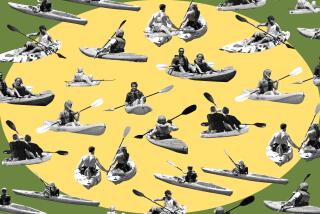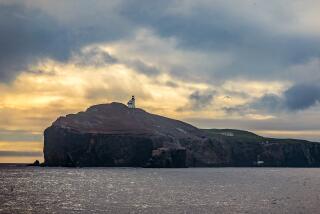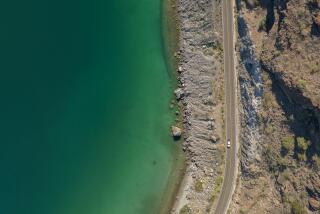Paddling Cay to Cay in Belize
Placencia, Belize â Less than an hour after I pushed my bright red kayak from the shore into the shimmering Caribbean Sea, the gentle breeze turned wrathful. No matter how vigorously I paddled, my banana-shaped boat refused to glide toward the fuzzy speck in the distance -- a tiny Belize cay (pronounced key) -- that was my intended destination. Instead, the gusts blew me to the left of the island, pointing my bow toward a vast, empty horizon.
The swells rocked my plastic boat violently as my numbing arms fruitlessly battled the choppy waters. Others in my kayaking group disappeared from view. As wave after wave washed over my hull, my stomach lurched in synchronicity.
I rested my paddle, leaned back and closed my eyes. I felt utterly defeated. I tried not to retch. Why was I here, I wondered.
Actually, there wasnât much that Andrea, my former New York roommate, had to do to persuade me to join her for some adventure travel. She was between jobs, and I had vacation time to kill. We had pondered luxuriating at a spa but then thumbed our noses at how dreadfully sedentary that seemed. We wanted to push our muscles, challenge our senses. We were City Girls, surrounded too long by material comforts, with something to prove.
We wanted to rough it.
And that we did, in our kayaking and island-hopping camping trip in Belize.
Andrea heard about the tripâs organizer, GAP Adventures, through referrals from friends. We checked out the Toronto-based tour groupâs Web site, and an eight-day kayaking tour along the Belize Barrier Reef in February seemed just right for us. It would end before Andrea would begin her new job. The price -- less than $1,000, excluding airfare -- was within each of our still-paying-back-student-loans budgets. And we were enticed by the other advertised activities: snorkeling along the worldâs second-largest barrier reef, possibly catching our own fish for dinner. Weather permitting, we could even sleep under the stars on the beach.
It took two flights, with a transfer in Houston, to bring me from Los Angeles to Belize City. As I stepped off the jet, I felt the welcoming embrace of Belizeâs temperate, humid air. A taxi with a badly cracked windshield and a penchant for stalling chugged me into the cityâs gritty downtown, where I met Andrea and the rest of our tour group at a budget hotel. Our crew of 10, which included a GAP leader, rose early the next morning to drive to the countryâs southern coast.
Our mode of transportation was a local âchicken bus,â the cheapest way for Belizeans -- as well as the occasional farm animal -- to get around other than on foot. Some in our group found the six-hour ride in the salvaged school bus uncomfortable, almost offensive. But I didnât mind. I was glad to see beautiful rolling hills and lush countryside as we rumbled down Hummingbird Highway, the countryâs most scenic route, even as we sat on cracked upholstery.
We turned onto Southern Highway, which isnât always paved and doesnât always seem wide enough for oncoming traffic, though cars zoomed past us anyway. It was midafternoon when our bus puttered down a small peninsula and screeched to a halt in the funky seaside village of Placencia. We were to embark for the islands the next day.
Placencia, a laid-back town of about 700 residents, is organized mostly along a 4,071-foot-long concrete walkway considered by all to be its Main Street. Dotted on each side with small hotels, modest shops and boxy wooden houses on stilts, the Sidewalk is the kind of place where even strangers canât help but socialize. Everyone says hello, and it is easy to strike up conversations. Most people in Belizeâs multiethnic mix of Creoles, Latinos, Garifunas and Mayas speak English, the official language of the former British colony.
The next morning we rented snorkels and plastic-wrapped our backpacks and sleeping bags to keep them dry for our motorboat ride to the islands near the reef, about 20 miles away. Local tour guides, working under contract to GAP, brought tents and cooking supplies. Another boat carrying our kayaks followed. As we skipped toward the open sea, my ponytail flapped in the wind like the tail of an excited puppy.
Belizeâs barrier reef, the longest in the Western Hemisphere, stretches for about 180 miles from the tip of the Yucatan Peninsula to the Gulf of Honduras. It is home to a vibrant ecosystem of dozens of coral species, hundreds of varieties of fish and countless other marine animals, such as dolphins, turtles and manatees. More than 400 small islands, or cays -- some lush with palm trees, others no more than barren sandbars piled with crushed coral and broken conch shells -- speckle the shallow, sun-drenched waters between the mainland and the reef.
Our motorboat arrived at Buttonwood Cay, an island slightly larger than an acre that is unfortunately still recovering from the devastation of Hurricane Iris. The October 2001 storm ravaged parts of Belize and decapitated countless palm trees, including many on this raggedy cay. Still, our camp buzzed with the enthusiasm of Brownies and Cub Scouts on their first jamboree. We made tuna sandwiches, pitched our own tents and sat around a big campfire. Because the night was so dark, the women in our group walked in pairs to the decrepit outhouse at the other end of the island.
I stretched out on top of my sleeping bag because it was so warm -- the temperature never seemed to dip below the 70s, even at night -- but remained in my tent because of the many small crabs scampering about outside. The sounds of crashing waves and wind rustling through palm fronds lulled me to sleep.
Our kayak adventures began the next day. My maiden voyage was a circle around Buttonwood in a two-person kayak with a fellow camper. I had rowed in the past with an intramural crew team and have been weight-training for years, so I found the paddling to be a cinch. When it was time for us to leave by kayak for our next campsite in the Silk Cays, I felt confident enough to set out on my own in a single-seat boat.
I paddled like clockwork as our lollipop-colored kayaks fanned out into the water. But the wind kept blowing me off course. I tried every steering technique I knew -- powering forward with my left blade only, thrusting the right blade out as a rudder -- to no avail. My boat would only rock and roll with the waves in a diagonal to the left.
Just after I lost sight of the other kayakers, our local guides, Hubert and Jimmy, vroomed up behind me in their motorboat and told me to get in. I staggered onto the deck and collapsed facedown onto a pile of backpacks. I was humiliated by my forced rescue and too seasick to move.
Others soon joined my fate. Our boat zipped over to Andreaâs kayak, which had also drifted off course, and towed her with a rope. We passed other kayakers; Jimmy told them to paddle to a nearby sandbar and leave their boats behind because wind conditions were becoming dangerous. The motorboat would head first to the Silk Cays with our gear, then return empty for the moored kayakers. No one in our group -- ranging in age from the 20s to the 40s, all of us in good physical shape -- would complete that dayâs journey by kayak.
Our motorboat ride to the Silk Cays was fast and rough, whipping us with salty spray. A chorus of yelps erupted as we were mercilessly bounced up and down on the hard bench seats.
Tiny island paradise
Our misery over the failed kayak run dissipated into delight when we neared the Silk Cays, a trio of teensy uninhabited islands without individual names. The one we claimed as ours is the second largest and by far the loveliest, with a dozen squat, leafy palm trees on one side and a sandy beach on the other. At only about 50 by 100 feet, this cashew-shaped islet is lush and pristine.
Andrea and I pitched our clover-green tent near a palm swollen with baby coconuts. By the time weâd pounded in the last stake, colorful hammocks cradling fellow campers seemed to have magically dropped between other trees.
I inquired about bathroom facilities, envisioning something comparable to the shack from the day before. Jimmy pointed to one end of the cay, just beyond the palm grove, where waves wash over rocks and there is a small strip of sand.
âYou just dig a hole,â Jimmy said, in a lilting Creole. âCover it up when youâre done.â
My incredulousness prompted Jimmy to repeat himself. One female camper immediately vowed to hold it in until our return to the mainland, in four more days.
Under the glitter of the Milky Way that night, I carried a digging stick as I gingerly approached what I feared was already a minefield. The subversive wind made it even more difficult to maintain dignity. I returned to my tent, mission accomplished but feeling degraded and demoralized.
But I, along with everyone else, eventually learned to adapt to life on the cays, if only because we had no alternative. I brushed my teeth with drinking water that weâd brought along, scrubbed out soiled clothing by rubbing it with wet sand. When a hermit crab crawled into my tent -- and my hair -- I picked up the critter by its shell, tossed it out, zipped up the tent flaps and went back to sleep.
On our third day of camping, the sea was glassy smooth as if to make up for its earlier petulance. I paddled with several others for a couple of miles out to the dark coral formations of the barrier reef. Hubert instructed us not to go beyond the reef, where the water was frothy and much rougher.
We circled over to a neighboring island, the largest of the Silk Cays, where we took a rest break. Then we power-stroked back to our home sweet tiny isle, where I fell asleep on a hammock to the mellow strains of Belizean reggae from a boombox that our tour group leader had brought along.
Front-row seat to nature
Later that afternoon I snorkeled in the fantastically warm water, which never seemed to be deeper than 15 feet. I floated above iridescent angelfish nibbling on sponges, butterflyfish darting in and out of coral caves, tiny gobies of spectacular neon hues, and turquoise puddingwives flitting past purple sea fans waving to and fro amid coral in the shapes of cactuses, domes and gnarled fingers.
As I swam into a school of minnows, each stroke of my arm jolted hundreds of small silvery fish to turn left, pivot right and do another about-face in perfect jittery unison. The large stingray and the nurse shark, though, glided past me with insouciance.
One of the neatest aspects of our trip was the extent to which we lived off the bounty of the land and sea. On one island we used dead palm fronds and coconut shells as firewood. On another, we gathered young coconuts for their juice to quench thirst and to mix with rum for an instant tropical cocktail. Although our guides had brought vegetables and condiments, nearly every lunch and dinner featured the daily catch. The guides spearfished with great success, and some of us joined the hunt. I reeled in an 8-pound barracuda. Another camper scooped up conch shells.
Our guides cooked all our meals, and we had fresh seafood every day: spicy mackerel stew with onions and tomatoes, fried jackfish, barracuda and potato soup, conch ceviche with bell pepper bits marinated in lime juice, and foil-wrapped red snapper baked with barbecue sauce.
Breakfast was usually made with food brought from the mainland, such as scrambled eggs with fried bread. The meals were so delicious that everyone went back for second and third helpings.
Altogether, including the sandbar where some kayakers were briefly marooned, we visited eight cays in five days. As we rode the motorboat back to Placencia, our clothes were streaked with grime. Andrea and I, both with shoulder-length tresses, had birdsâ nests for hair. The guysâ unshaven chins were scraggly. Except for dips in the sea, no one had bathed since we left the mainland.
âItâs going to be strange to see myself in a mirror again,â one camper said.
Yet the trip provided a true reflection of our strengths, resolve and limitations that no looking glass could. By the end, Andrea was suffering from excruciating muscle aches from too much paddling. The soft, moist air I so loved helped fuel an agonizing heat rash all over my arms and legs.
As much as I enjoyed communing with nature and the open sea, I was ready to go home for some pampering.
Now kicking back at a spa didnât sound so bad after all.
More to Read
Sign up for The Wild
Weâll help you find the best places to hike, bike and run, as well as the perfect silent spots for meditation and yoga.
You may occasionally receive promotional content from the Los Angeles Times.






